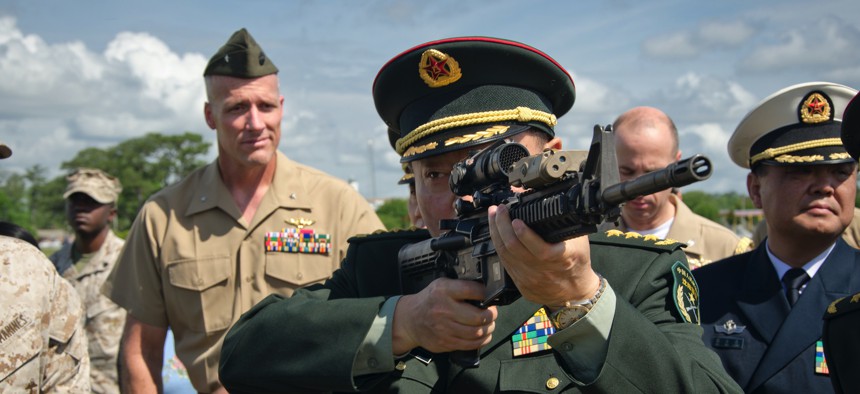
One of the general officers accompanying China's Minister of National Defense shoulders an M4 carbine during a 2012 visit to Marine Corps Base Camp Lejeune, N.C. Marine Corps Cpl. Bryan Nygaard
Building a China Strategy Starts by Answering These Questions
To begin, we must question our perceptions and eliminate our biases.
“The Chinese bear their ills not only with fortitude, but what is often far more difficult, with patience.” — Arthur Henderson Smith, Protestant missionary in China (1872-1926)
The book Chinese Characteristics makes many insightful and important observations. Based on our interactions with Chinese counterparts over a two-year period — as the Indo-Pacific Command’s director of strategy and policy and an Olmsted Scholar in Shanghai, respectively — we found timeless wisdom in many of Arthur Henderson Smith’s observations. The Chinese perception of time, their approach to political-military relations, and their messaging discipline is a reflection of their determined culture. In terms of time, Americans are impatient; the Chinese are not. In fact, the Chinese are patient to the point of obstinance. The Chinese take the “long view” and develop strategy that spans decades, while the United States operates within the temporal confines of bureaucratic inter-agency infighting, partisan politics, and four-year election cycles. Given these factors, what is the best strategy toward China in this decade and beyond? How can it be determined? To begin with, we believe we must question our perceptions and eliminate our biases regarding China. We then need to answer three fundamental questions in order to craft an effective and viable China strategy.
China presents both promise and peril to the global world order. Given this challenging paradox, any solution to the China problem will need to be sophisticated; integrated across federal and state governments, as well as public and private industry; it will be a whole-of-society answer. We owe it to the American people to explore all aspects of our future relationship with China. This process starts by answering the below, which then creates a framework for a more creative and actionable China strategy.
First, what problem are we trying to solve regarding China? If it is China not playing by our “rules,” we must realize that China will only play by our rules if we incentivize them to do so. What are those incentives? Are new or modified rules possible? Is the real problem in the way we look at the “China problem”?
Second, what would success look like with China in terms of cooperation and/or deterrence? Do we seek co-existence or containment?
Third, if we were to enter into armed conflict with China, what would victory look like? How would war with China unfold? Would the cost of this conflict be worth the investment in human treasure? What kind of war would we envision and to what end?
As we question our assumptions, we should caution ourselves against viewing our relationship with China through a Cold War prism. China is not the Soviet Union, especially in the economic realm. Our comprehension of China is obscured by a “lost in translation” cultural, political, and language divide. This makes our assumptions, insights, and perceptions of China tenuous, especially when our ethno-centrism and mirror-imaging biases come into play.
We need to eliminate these biases in order to effectively integrate all levers of U.S. national power into a multi-dimensional China strategy. In this effort we also need to address U.S. domestic issues that threaten our livelihood and ability to action this strategy, specifically our budget deficit, growing wealth disparity, and radical political extremism.
Rather than a new Cold War, we are now embroiled in a 21st-century version of the Great Game, but unlike Russia and Great Britain in the last two centuries, the stakes for the United States, China, and the global community today, are much higher. The U.S.-China relationship will be the defining nation-state relationship of this century.
Areas of potential cooperation exist. Sustainable development, environmental considerations for the Mekong River Delta, equitable trade relationships including U.S. agricultural goods, international standards for the use of space; these can be leveraged to promote stability. Still, there must also be clear boundaries and distinct consequences for malign acts: the genocide of the Uighur people, threats to the Republic of China, violations of sovereignty across the South and East China Seas, intellectual property theft — these cannot go unanswered. Boycotts, tariffs, fines, support to other nations’ sovereign claims, and assistance to allies in the form of naval presence must all correspond to clearly articulated U.S. policy. The relationship must be approached in a very nuanced way, reconciling both countries’ interests and minimizing triggers that could lead to conflict by eliminating strategic ambiguities.
The world we live in demands an agile China strategy tempered by pragmatic “realpolitik” principles. The design and implementation of that strategy requires a new level of thinking — one that acknowledges the complexities of China’s status as our trading partner, its strategic patience, and its vision of global dominance. We must counter this with a disciplined focus on our own strategic goals. It is a strategy that requires inter-agency cooperation, operationalized to address the multi-domain threats of hybrid warfare, and it demands resourcing through budgets commensurate with the challenge posed to the United States.
The team charged with the coming strategy development task will benefit by starting with a “clean white board” and by questioning conventional wisdom on China. Only then will we effectively answer the fundamental questions, define the parameters of our strategy, and create insightful and impactful ways to address the China problem.
Mike Dana served in the U.S. Marine Corps for 37 years, retiring as a lieutenant general in 2019.
Lt. Col. Matthew R. Crouch, U.S. Marine Corps, is a Senior Military Fellow at the Atlantic Council’s Scowcroft Center for Strategy and Security.
The views and opinions expressed here are those of the authors and do not necessarily reflect the official policy or position of the U.S. Marine Corps, Department of Defense, any agency of the U.S. government or other organization.




